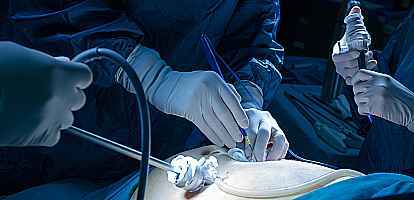Cystocele Repair
Introduction
A cystocele is a type of pelvic organ prolapse. When there is a weakness in the front wall of the vagina, the bladder can prolapse into the vagina. This is called a cystocele.
Women may describe a dragging sensation or pressure in the vagina. Some can feel a lump protruding out of the vagina. Large lumps can rub against the underwear and ulcerate. Some describe painful intercourse. Voiding symptoms such as difficulty emptying the bladder may be described. This can sometimes cause recurrent bladder infections. There may be associated urinary incontinence with physical exertion (female stress urinary incontinence). Sometimes, manual reduction of the prolapse with the hands (splinting) is described to ease with passing of urine. Very rarely, a prolapse may be large enough to block the ureters (tubes that drain the kidneys to the bladder), causing kidney damage.
The anterior colporrhaphy surgery for cystocele repair does not involve the use of mesh. Success rates are 70% - 90%.
Indications
Anterior vaginal wall prolapse (cystocele) that is bothersome or starting to cause complications.
Preoperative Instructions
If you are taking blood thinners or certain newer diabetic medications, please inform your doctor as these may have to be stopped before the surgery.
You will need to fast for at least 6 hours before the surgery.
Your doctor may require you to have blood tests or a urine test prior to the surgery.
See preparing for surgery, for more detailed instructions.
Procedure
This is done under spinal or general anaesthesia. Intravenous antibiotics are given. A catheter is placed to drain the bladder.
A midline vertical vaginal incision is made where the defect is, at the anterior vaginal wall. The prolapsed bladder is freed up. Delayed absorbable or permanent sutures are placed to approximate the supportive layers from laterally to the midline (plication). This creates more support for the bladder.
A cystoscopy is done to check for damage to the bladder or urethra, and to ensure the ureters are not kinked off.
Occasionally a pubovaginal fascial sling may be placed to treat associated stress urinary incontinence or for more support to reduce the rate of recurrence.
The vaginal wound is then closed. Sometimes, excessive vaginal skin is trimmed off. A pack is placed in the vagina.
Postoperative Instructions
Most patients stay in the hospital for 1 to 2 days. The vaginal pack is removed on day 1. Patients are encouraged to mobilise. The catheter is removed on either day 1 or 2, depending on your pain level and mobility. If the patient is voiding satisfactorily, she can then go home.
The vaginal incision usually does not cause much post-op pain. Some creamy white vaginal discharge may be expected for the first few weeks. This is due to the presence of dissolvable sutures in the vagina. About a week post-op, some blood-stained vaginal discharge may happen. This is due to the breakdown of old blood trapped under the skin. If the discharge is offensive-smelling, see your GP in case you need to go on oral antibiotics.
After the surgery, patients are advised not to do heavy lifting or strenuous activities for 6 weeks. You can do light duties at home including walking up 1-2 flights of stairs, going for short walks, and going to the shops in the first few weeks. Slowly increase your activity level as you become more comfortable.
Take your pain medication as directed. You may need to take it as soon as you start feeling uncomfortable (before the pain gets severe).
Do not drive for at least 3 to 5 days as you may still have some post-op pain.
No sexual intercourse for 6 weeks as the vaginal wound needs time to heal.
Check with your doctor when you can go back to work as the type of work that you do will determine this. In general, if your work is not too physically demanding, you can go back to work in 3 to 4 weeks. If it is more demanding, you may need about 6 weeks off work.
You should attend your post-op appointment so your doctor can check for any complications.
Risks
General risks:
- Anaesthetic risks such as heart or lung problems.
- Wound infection – you will be covered with antibiotics during the surgery.
- Bleeding – it is uncommon (<1%) to need a blood transfusion for this surgery.
- Clots in the legs (DVT) or pulmonary emboli.
- Chest infection, urinary tract infection.
- Allergic reactions (e.g., to dressings, drugs etc.) – inform us if you have any known allergies.
- Risk of death is a very rare complication that may arise from any surgery or anaesthetic. Modern medicine and anaesthesia have made this extremely rare. The risk varies with each individual’s general health conditions and the complexity of the surgery. The cystocele repair is not considered to be a major surgery.
Specific risks:
- Recurrence of prolapse (5% to 20%).
- Bladder, urethra or ureteric (tubes that drain the kidneys to the bladder) injury (<1%). A cystoscopy is always done during the surgery to check for this.
- Unmasking stress urinary incontinence (1% to 5%).
- Difficulty passing urine or urinary retention (1% to 2%). Rarely, a plication suture may have to be taken down to restore normal voiding.
- Painful intercourse (uncommon). Most women experience improvement in sexual function after prolapse repair.
- Fistula formation (0.1%) can occur in patients with unrecognised damage to the bladder or urethra. Here, the fistula is an abnormal connection that can drain the bladder to the vagina directly, causing incontinence.
Treatment Alternatives
See pelvic organ prolapse for treatment alternatives.
Related Information
Read A/Prof Gani’s publication:
Download Long term surgical outcome of anterior colporrhaphy and autologous fascial sling (afs) reinforcement for treatment of high grade cystocoele - PDF (531 Kb)

